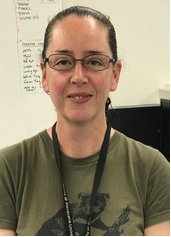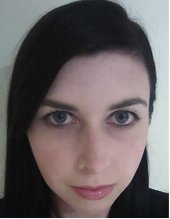Royal Society of NSW News & Events
1270th OGM and open lecture
Royal Society of NSW Scholarship Award Winners for 2018
Fiona McDougall, Department of Biological Sciences, Macquarie University
Evelyn Todd, School of Life and Environmental Sciences, University of Sydney
There was also a 3-minute thesis (3MT) talk: “Finding the best-fitting jeans for railway foundations” by Mr Chuhao Liu, 2018 3MT winner, University of Wollongong.
Wednesday 6 February 2019
Gallery Room, State Library of NSW
Royal Society of NSW Scholarships
The Royal Society of New South Wales Scholarships recognise outstanding achievements by individuals working towards a research degree in a science-related field within New South Wales or the Australian Capital Territory. Each year up to three scholarships of $500 plus and a complimentary year of membership of the Society are awarded. The award winners give talks about their research at the first OGM each year.
 Fiona McDougall
Fiona McDougall
Department of Biological Sciences, Macquarie University
“Human-associated bacteria and antibiotic resistance in grey-headed flying foxes”
Over recent decades, the number of grey-headed flying foxes (also known as fruit bats) roosting in urban environments has increased dramatically. Each year, several thousand sick, injured and orphaned flying foxes enter wildlife rehabilitation facilities. In urban areas and rehabilitation facilities, flying foxes encounter human-associated bacteria which may be pathogenic. At present, the transmission of human-associated organisms between humans and flying foxes is poorly understood. Additionally, antibiotic-resistant bacteria are spreading from humans to wildlife; currently there is a paucity of surveillance data on the spread of antibiotic resistance into Australian wildlife, including flying foxes.
This research examining the spread of human-associated bacteria (escherichia coli and klebsiella pneumoniae) to flying foxes is providing insight into the unique diversity and ecology of these bacteria in the grey-headed flying fox (pteropus poliocephalus). Flying foxes have also acquired antibiotic-resistant bacteria, including multidrug-resistant escherichia coli, in both urban and rehabilitation settings. The prevalence of genetic determinants of antibiotic resistance is higher in flying foxes in rehabilitation facilities than in wild urban flying foxes. We are yet to understand the implications of these findings on the management and conservation of the endangered grey-headed flying fox.
Fiona McDougall obtained a Bachelor of Veterinary Science from the University of Sydney in 1998 and subsequently spent over ten years working as a veterinarian and conducting biomedical and wildlife research. In 2013 she obtained a Master of Veterinary Studies in conservation medicine from Murdoch University. She is currently in the third year of her PhD at Macquarie University. In 2017 she was awarded a Holsworth Wildlife Research Endowment grant, and she is also a co-investigator on a Lake Macquarie Environmental Trust grant (2017).
 Evelyn Todd
Evelyn Todd
School of Life and Environmental Sciences, University of Sydney
“Using genetics to improve athletic performance in thoroughbred horses”
Thoroughbred horse racing holds both historical and economic significance in Australian society, dating back to the early colonial years of settlement. The thoroughbred racing and breeding industry is also a major contributor to the Australian economy due to the internationally recognised quality of the horses it produces.
The thoroughbred horse breed was founded in the 18th century, making it the oldest closed animal population in the world. Uniquely, all modern thoroughbred horses throughout the world trace their pedigree back to this time (an average of 24 generations). Although thoroughbreds are the product of many generations of inbreeding for the selection of racing performance, the population is still viable and thriving. Evelyn's research examines how these many generations of selective breeding has influenced the genetic characteristics of modern thoroughbred horses. These findings assist in understanding the effects of long-term selection on the health and viability of animal populations.
Evelyn Todd is a PhD student at University of Sydney, researching and writing a thesis titled “Inbreeding and performance genetics in horses”. She started her PhD candidature at the beginning of 2017, having completed a Bachelor of Science (Honours) in 2015. Her self-directed honours thesis focussed on the effects of inbreeding on racing performance in thoroughbred horses. After completing her undergraduate degree, she spent a year working in industry before returning to postgraduate study. Her PhD aims to understand genetic trends in horse populations, particularly focussing on thoroughbred racehorses.
Three-minute thesis (3MT) talk
The Three-Minute Thesis (3MT) competition brings together some of the best and brightest PhD students, who have just three minutes to explain what they are doing, how they are doing it, and why it is important. The competition cultivates students’ academic, presentation, and research communication skills, and their capacity to communicate complex ideas to a non-specialist audience. Competitors are allowed one PowerPoint slide, but no other resources or props.
This month’s presentation, “Finding the best-fitting jeans for railway foundations”, was by Mr Chuhao Liu, Faculty of Engineering and Information Sciences, University of Wollongong, winner of the University of Wollongong 2018 3MT competition.
Train is a very popular choice for travelling and freight transport in Australia. However, track foundation particles (ballast) are almost free to move laterally and subjected to significant breakage upon repeated train passage. To solve this problem, industry currently installs a plastic grid, named Geogrid, inside the railway foundations. But the best design of geogrid remains an open question. The research aims to find out the optimum design of geogrid, especially the size of the hole (aperture) on the grid, and develop a standard for rail manufacturing.

